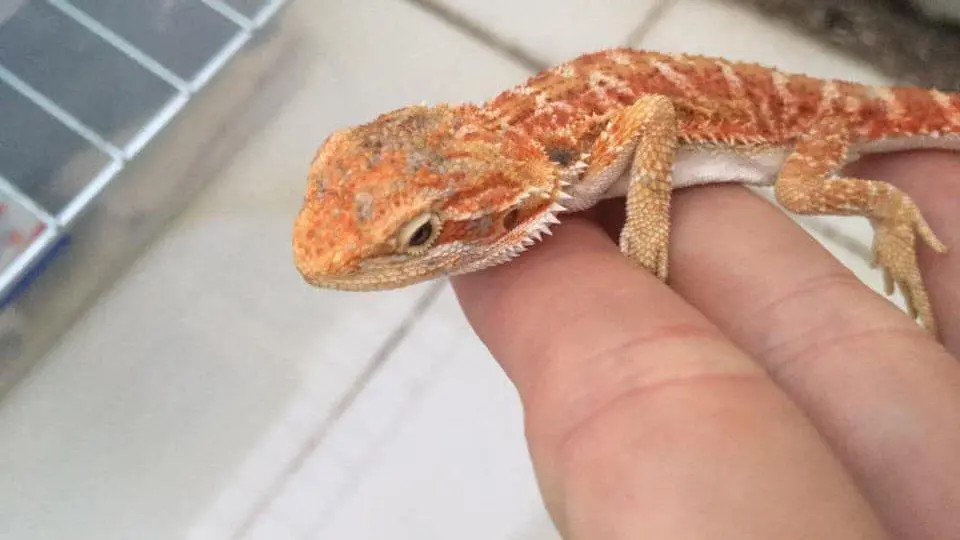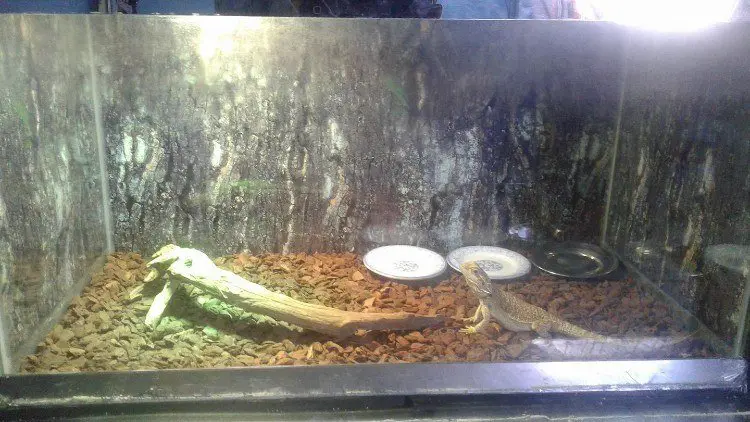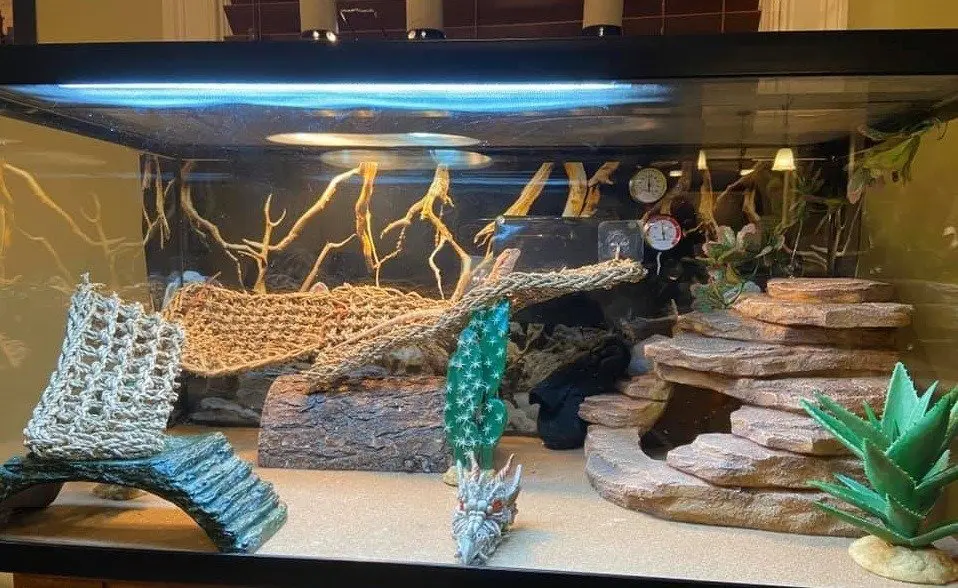As with any pet you own in your life, a bearded dragon can get sick from time to time. One of the diseases your bearded dragon may experience is a respiratory infection. While a respiratory infection is relatively common in dragons, not providing adequate treatment can result in death.
Understanding what a respiratory infection is, the symptoms and how to treat it is the best way forward for your beardy, ensuring that it remains happy and healthy moving forward.
What Is A Respiratory Infection In Bearded Dragons
A respiratory infection is when a dragon has problems breathing. There is a URI, or upper respiratory infection, which is a lung based bacterial infection which is caused by excess moisture in the dragon habitat.
This type of illness in your dragon can prove fatal, if you don’t take immediate action to treat your dragon to ensure their best health in the long run.
Bearded Dragon Respiratory Infection Signs And Symptoms

There are some common signs and symptoms you can look out for if you think your dragon may have a respiratory infection. Your dragon may show one or a few of the signs listed below.
- Black beard for six hours or more
- Bubbly or stringy mucus on side of mouth
- Decreased appetite
- Difficulty breathing, may open mouth to breathe
- Lethargy
- Mouth gaping
- Puffing of the throat
- Sneezing and/or snorting
- Swelling / bloating of the body
- Weight loss
Respiratory Infection Causes in Bearded Dragons
The bearded dragon’s natural habitat is in the hot desert of Australia. The dragon spends its day soaking up the sun and therefore to reduce the risk of illness, beardy owners will want to ensure that they provide the right habitat conditions for the best results.
Wrong Temperature / Increased Humidity
The most common cause of many respiratory infections in bearded dragons is incorrect temperatures, humidity and insufficient UVB light.
A drop in temperature can result in the humidity in the enclosure rising, which will result in numerous issues, one of them being the increased risk of a respiratory infection.
Humidity levels should remain between 30 and 40% with basking temperatures around 95ºF to 105ºF for adults with the cool side being around 80ºF to 85ºF.
Further Reading:
- How to setup the correct temperature for your bearded dragon
- How to provide proper UVB light for your bearded dragon
Wrong Substrate

Bark substrate is not recommended for bearded dragon
Using the wrong substrate can result in a sick beardy. Mulch or bark can be very dangerous to your bearded dragon. They can cause impaction and they can cause a respiratory infection by retaining humidity.
Further Reading:
Poor Bathing Methods
Most bearded dragons enjoy a bath now and then. Some owners will bathe their dragons a few times a week, others claim it’s not necessary.
Bath levels need to be closely monitored to ensure your bearded dragons vents are not covered when he stands in the water. High levels in the bath can cause your dragon to breathe in water, which then aspirates in their lungs.
Bearded Dragon Respiratory Infection Treatment
If you think there is the slight possibility your bearded dragon has a respiratory infection, the best thing to do is head to the vet immediately. A vet can provide an accurate diagnosis and provide the right treatment to get your dragon back to being a happy and healthy reptile.
Vets will provide medication which you will need to administer using a syringe. This is usually given daily. The dosage is determined by the vet based on your dragon’s size.
Visit the Vet
If you suspect that your bearded dragon is suffering from respiratory disease, you should take them to a reptile vet immediately.
A reptile vet can provide accurate diagnosis and correct treatment, probably requiring medication. Your dragon may be given medication to administer daily, orally, using a syringe. The dosage depends on the size of your dragon.
You should also find the cause of the disease and correct it for the future health of your dragons.
Environmental Changes

There are also some environmental changes you can make to ensure that your bearded dragon starts to heal quickly. A respiratory infection could be a result of excess moisture, which can be treated with an increase in temperature.
The hot side of the tank where your basking area is should be between 95ºF/ 35ºC and 105ºF/41ºC. Baby dragons enjoy the basking side of their enclosure to range between 105ºF/41ºC and 110ºF/43ºC. To burn off extra moisture, you can increase the temperature by up to five degrees Fahrenheit.
Ensure you have a thermometer in place to help you monitor your temperatures easily and ensure that your dragon remains healthy and happy. Making environmental changes can help your bearded dragon with recovery, in addition to the treatment provided by the reptile vet.
Bearded Dragon Respiratory Infection Prevention
As a bearded dragon owner, it is better for your dragon and easier for you to work on the principle of prevention always being better than a cure. If you can, try and avoid any bearded dragon disease.
Temperature and Humidity Levels
Bearded dragons’ natural habitat is the desert, they are used a dry and hot climate. In order to reduce your dragon getting a respiratory infection, you want to make their habitat as close to nature as possible, which means maintaining humidity levels at between thirty and forty percent. Humidity levels in a dragon’s tank should never be more than forty percent.
Temperature levels need to be maintained. The temperature has an impact on humidity and when you’re trying to reduce humidity levels to eliminate the risk of moisture getting into your dragon lungs, you will want to increase the temperature by up to five degrees more than usual.
To recap what was discussed above:
Basking side temperature (Adults) – 95ºF/35ºC to 105ºF/41ºC
Basking side temperature (Babies) – 105ºF/41ºC to 110ºF/43ºF
Reduce Stress

Stress in bearded dragon can cause serious problems
The best way to keep a healthy bearded dragon is to reduce their stress levels. These reptiles are easily stressed and stress results in a weaker immune system.
Stress often results when a bearded dragon enclosure setup is wrong. This is often seen in the first few days of bringing your new dragon home.
You can reduce stress by giving your beardy a warm bath, reduce how much you handle them and reduce any outside stimuli. After a while you will find what your dragon is and isn’t comfortable with, making it easier for you to reduce any stress in the long run.
A Clean Habitat
Keeping your dragon’s habitat clean is an essential preventative measure which can reduce most illnesses, not only respiratory infections.
The problem is that an enclosure is a great home for dirt and mold. A thorough cleaning should be conducted at least every month with spot cleaning in between.
Substrate
The substrate you choose will prevent the risk of your bearded dragon getting a respiratory infection. Recommended substrates for bearded dragons are reptile carpet, ceramic tiles and shelf liner.
Conclusion
You now have all the relevant information you need at your fingertips to ensure the best health for your beardy with the opportunity to prevent respiratory infection by knowing the causes, symptoms and treatments.
Get to know your pet and monitor them regularly so you can identify any problems quickly to ensure prompt treatment at all times.
I needed some help my bearded dragon is deep breathing some loose drain from his eyes and nose i think it’s a Respiratory infection I been on the phone for days and no one takes reptiles any other advise I live in providence Rhode Island